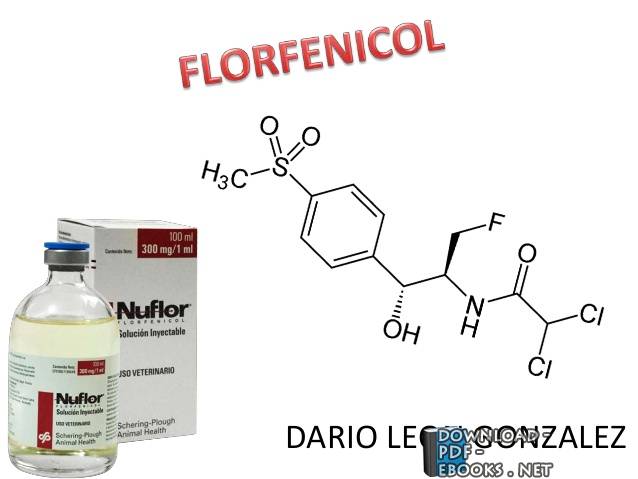📘 قراءة كتاب Florfenicol أونلاين


Florfenicol من كتب طب بيطرى
FLORFENICOL
(بيطري - جهازي )
بعض
الأسماء التجارية الشائعة الاستخدام
للمنتجات ذات العلامات البيطرية
هي:
Aquaflor
و
Nuflor.
ملاحظة: للحصول على قائمة بأشكال الجرعات والأسماء التجارية حسب
توفر البلد ، راجع قسم (أقسام)
نماذج الجرعات
.
التصنيف:
مضاد للجراثيم (جهازي).
مؤشرات
ملحوظة: يصف النص بين
EL
US
و
EL
الاستخدامات التي لم يتم تضمينها
في ملصقات المنتجات الأمريكية. يصف النص بين
EL
CAN
و
EL
الاستخدامات
التي لم يتم تضمينها في ملصقات المنتجات الكندية.
و
EL
الولايات المتحدة
أو
EL
CAN
تسمية يمكن أن تدل على عدم وجود المنتج
توفر في وأشار البلاد. راجع قسم
أشكال الجرعات
في هذه الدراسة لتأكيد التوافر.
اعتبارات عامة فلورفينيكول هو مضاد حيوي
واسع الطيف
ومقاوم للجراثيم
وله نطاق من النشاط مشابه لنشاط
الكلورامفينيكول ،
بما في ذلك العديد من الكائنات سالبة الجرام وإيجابية الجرام ؛
{R-1}
ومع ذلك ، لا يحمل florfenicol مخاطر التسبب
في
فقر الدم اللاتنسجي البشري
المرتبط بالكلورامفينيكول.
{R-13}
تم عرض فلورفينيكول
onstrated أن تكون نشطة
في المختبر
و
في الجسم الحي
ضد
Mannheimia (الباستوريلة) الحالة للدم، الباستوريلة
القتالة،
و
المستدمية somnus.
{R-1 ؛ 2}
أظهرت
الدراسات في المختبر
نشاط فلورفينيكول ضد
Enterobacter cloacae و
Escherichia coli و Klebsiella pneumoniae و Salmonella typhi
و
Shigella dysenteriae
{R-2؛ 15؛ 16}
ولكن مع ما لا يقل عن 10 2- لأضعاف
أعلى الحد الأدنى المثبطة يخدع
وحدانية التركيز من ذلك ل
Mannheimia، الباستوريلة
و
المستدمية
الأنواع المدرجة
أعلاه.
{R-15 ؛ 16}
كما أن له نشاطًا ضد بعض
سلالات البكتيريا المقاومة للكلورامفينيكول ،
{R-17}
ربما لأنه أقل تأثرًا
بالأنزيم الرئيسي المنتج في المقاومة
البكتيرية بوساطة البلازميد
ضد الكلورام
الفينيكول والثيامفينيكول.
{R-2 ؛ 26} على
الرغم من أن نشاط florfenicol ضد اللاهوائية الملزمة
لم يتم تناوله في الأدبيات ، فمن
المحتمل أن يكون فعالاً للغاية.
{R-28}
مقبول
EL
CAN
تسمم الدم المعوي (العلاج)
EL
-
سمك السلور: يُشار إلى مادة
فلورفينيكول من النوع أ
في
السيطرة على الوفيات بسبب
تسمم الدم المعوي الناجم عن
سلالات حساسة من
Edwardsiella
ictaluri
.
{R-36}
EL
US
Furunculosis (العلاج)
EL
-
Salmon:
Florfenicol Type A
يُشار إلى مقال طبي في علاج داء الدمامل
الناجم عن سلالات حساسة من
Aeromonas salmonicida
.
{R-11}
EL
US
Keratoconjunctivitis ، العدوى (العلاج)
EL
-
Cattle: يشار إلى حقن
الفلورفينيكول
في ملصق المنتج الكندي في
علاج التهاب القرنية والملتحمة البقري المعدي الناجم عن
Moraxella bovis.
{R-3 ؛ 33 ؛ 34}
الالتهاب الرئوي والبكتيرية (العلاج) -
الأنعام:
يشار إلى حقن Florfenicol في علاج
الالتهاب الرئوي الجرثومي وما يرتبط بها من التهابات الجهاز التنفسي
(أمراض الجهاز التنفسي البقري
معقدة) في الماشية التي تسببها
عرضة
somnus H.، M. الحالة للدم،
و
P. القتالة.
{R-1 ؛
3}
EL
CAN
يشار حقن Florfenicol أيضا في السيطرة على
الالتهاب الرئوي الجرثومي وما يرتبط بها من أمراض الجهاز التنفسي في
الماشية في خطر كبير لتطوير العدوى المرتبطة
عرضة
somnus H.، M. الحالة للدم،
و
P. القتالة.
EL
{R-
1 ؛ 3 ؛ 32}
الخنازير
: يُشار إلى
EL
CAN
Florfenicol عن طريق الفم
EL
و
EL
US
florfenicol injection
EL
في علاج الالتهاب الرئوي الجرثومي
والتهابات الجهاز التنفسي المصاحبة
التي تسببها حساسية
Actinobacillus pleuropneumoniae و
P. multocida و
EL
CAN
Salmonella choleraesuis
و
Streptococcus suis
Type
2
EL
.
{R-3 ؛ 37}
التهاب الجلد ، المعدي (العلاج) -
الماشية:
يشار
إلى حقن
الفلورفينيكول في علاج التهاب الجلد المعدي.
(فلغمون بين الأصابع) أسو
ciated مع عرضة
باكتيرويديز
الميلانينية
و
المغزلية الناخرة.
{R-1 ؛ 3 ؛ 30}
اعتبارات تنظيمية في
الولايات المتحدة -
تم تحديد أوقات السحب
للفلورفينيكول في سمك السلور
والماشية. ومع ذلك ، لم يتم تصنيفها للاستخدام في
الأبقار الحلوب المرضعة أو في عجول العجل
(انظر قسم
أشكال الجرعات
).
{R-1 ؛ 36}
كندا -
تم تحديد أوقات السحب
للفلورفينيكول في الأبقار
والسلمون. ومع ذلك ، لم يتم
تصنيفها للاستخدام في
الأبقار الحلوب المرضعة
أو في عجول العجل (انظر
أشكال الجرعات
الجزء).
{R-3 ؛ 11} مصدر
الكيمياء
:
مشتق مفلور من ثيامفينيكول.
{R-12}
الاسم الكيميائي:
أسيتاميد ، 2،2-ثنائي كلورو-
N
- [1- (فلوروميثيل) -2-
هيدروكسي-2- [4- (ميثيل سلفونيل) فينيل] إيثيل] - [
R
- (
R * ، S *
)] -.
{R-4}
الصيغة الجزيئية:
C
12
H
14
C
l2
FNO
4
S.
{R-14}
الوزن الجزيئي:
358.21.
{R-4}
الوصف:
نقطة الانصهار 153 إلى 154
درجة
مئوية
{R-12}
الذوبان:
قابل للذوبان في الماء.
{R-12 ؛ 13}
قابل للذوبان في الدهون.
{R-13}
علم الأدوية / حركية الدواء
آلية التأثير / التأثير:
فلورفينيكول
مضاد حيوي مضاد للجراثيم يثبط تخليق البروتين عن طريق الارتباط بالوحدات الريبوزومية
للبكتيريا الحساسة
، مما يؤدي إلى تثبيط
الببتيدل ترانسفيراز
{R-1 ؛ 13 ؛ 26}
وبالتالي منع انتقال
الأحماض الأمينية إلى
سلاسل الببتيد النامية
وتكوين البروتين اللاحق . يُعتبر المستقبل البكتيري الذي هو موقع عمل
فلورفينيكول هو نفسه بالنسبة
للكلورامفينيكول والثيامفينيكول.
{R-13 ؛ 26}
في علاج
أمراض الجهاز التنفسي البقري، يمكن اعتبار florfenicol
جراثيم ضد بعض
Mannheimia
(
الباستوريلة) hemolytica
و
الباستوريلة القتالة
عندما يدار لتحقيق
التركيز المثبط الأدنى (البلدان المتوسطة الدخل)؛
{R-14}
الحد الأدنى
لتركيزات مبيد الجراثيم (MBCs) قريب جدًا من MICs.
يحتوي فلورفينيكول على ذرة فلور بدلاً من مجموعة الهيدروكسيل الموجودة
في C-3 في بنية ch
loramphenicol و thiamphenicol.
{R-13}
قد يسمح هذا للفلورفينيكول بأن يكون
أقل عرضة للتعطيل
بواسطة البكتيريا ذات
المقاومة التي تنقل البلازميد والتي تتضمن
أستلة
مجموعة هيدروكسيل C-3 في الكلورامفينيكول
والثيامفينيكول ، ويمنع
التفاعل مع
الريبوسومات البكتيرية .
{R-13 ؛ 26}
إجراءات / تأثيرات أخرى:
فلورفينيكول ، مثل ثيامفينيكول ، يفتقر إلى
مجموعة النيترو الموجودة على الحلقة العطرية للكلورامفينيكول التي
ارتبطت بفقر الدم اللاتنسجي
الناجم عن الكلورامفينيكول ، وغير المرتبط بالجرعة ، والذي
لا رجعة فيه.
{R-13 ؛ 24 ؛ 25}
ومع ذلك،
الكلورامفينيكول وthiamphenico
لتر أيضا سبب لذلك، تعتمد على الجرعة
عكسها نخاع العظم في بعض الحيوانات و
الناس
{R-13}
بسبب الاصابة الميتوكوندريا.
{R-24}
من
الممكن نظريًا أن يتسبب florfenicol coul
d في بعض
تثبيط نخاع العظم المعتمد على الجرعة والعكس ، ولكن لم يتم
الإبلاغ عنه سريريًا .
{R-13}
الامتصاص:
التوافر البيولوجي - الإعطاء
العضلي:
العجول ، من
3 إلى 6 أشهر من العمر - 78.5٪ (من 59.3 إلى 106٪) ،
بجرعة 20 مجم لكل كيلوجرام من وزن الجسم (مجم / كجم).
{R-1 ؛
2 ؛ 8}
الأبقار ،
المرضعات: 38
±
14٪ ، بجرعة 20 مجم / كجم.
{R-9}
الخيول
—81٪ ، بجرعة 22 مجم / كجم
Florfenicol
florfenicol في الدواجن
florfenicol حقن
florfenicol الذوبان
فلورفينيكول
حجم الكتاب عند التحميل : 164.5 كيلوبايت .
نوع الكتاب : pdf.
عداد القراءة:
اذا اعجبك الكتاب فضلاً اضغط على أعجبني و يمكنك تحميله من هنا:

شكرًا لمساهمتكم
شكراً لمساهمتكم معنا في الإرتقاء بمستوى المكتبة ، يمكنكم االتبليغ عن اخطاء او سوء اختيار للكتب وتصنيفها ومحتواها ، أو كتاب يُمنع نشره ، او محمي بحقوق طبع ونشر ، فضلاً قم بالتبليغ عن الكتاب المُخالف:
 قبل تحميل الكتاب ..
قبل تحميل الكتاب ..
يجب ان يتوفر لديكم برنامج تشغيل وقراءة ملفات pdf
يمكن تحميلة من هنا 'http://get.adobe.com/reader/'


 منصّة المكتبة
منصّة المكتبة